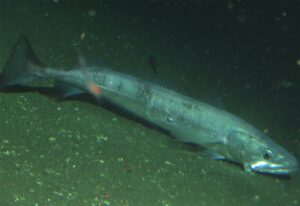The Atlantic Horse Mackerel fish is a species of Jack Mackerel in the family Carangidae.
It is also known by some other names such as Scad, Common Scad, Saurel, European Horse Mackerel, Pollock, Western Horse Mackerel etc.
It gets it’s common name from the legend that other smaller species of fish could ride on it’s back over great distances.
The Atlantic Horse Mackerel fish can be found in the eastern Atlantic from Norway to South Africa, including Iceland, the Azores, the Canary Islands, and Cape Verde.
And it is also found in the Mediterranean and the Black Sea. The fish is generally found to depths of 200 meters, although there are records extending the depth range to over 1,000 meters.
Currently the Atlantic Horse Mackerel fish is a widespread species and is the most abundant.
The majority of it’s global population is thought to occur from Senegal northwards. It is overfished in some parts of the Mediterranean. Read some more information about this fish species below.
Atlantic Horse Mackerel Fish Characteristics
The Atlantic Horse Mackerel fish has an elongate and fairy compressed body. Their head is large, and the posterior end of upper jaw reaching anterior margin of eye and the lower jaw is projected.
Their maxilla is large and wide, not covered by lachrymal. The adipose eyelid is well developed. They have small nostrils which are closely situated each other, anterior nostril oval and posterior nostril crescent.
In case of coloration, the upper part of the Atlantic Horse Mackerel fish’s body and top of the head is dusky to nearly black or grey to bluish green.
But the lower two thirds of the body and head is usually paler, whitish to silvery. They have no distinctive markings except for a small, black opercular spot on edge near upper angle.
Generally average body length of the Atlantic Horse Mackerel fish is around 22 cm, with a maximum recorded total body length of 70 cm.

Maximum recorded body weight of the mature fish is about 2 kg. Photo and info from FAO and Wikipedia.
Diet
The Atlantic Horse Mackerel fish are generally feed on crustaceans, squid and other fishes.
Breeding
The Atlantic Horse Mackerel fish are batch spanners. Spawning generally occurs during the summer, and they lay pelagic eggs.
Generally the females can lay up to 140,000 eggs per spawning. The females generally become mature within their 2-4 years of age.
Uses
The Atlantic Horse Mackerel fish is used for food. It is utilized fresh, frozen, canned and smoked. It can be broiled, fried and baked.
Special Notes
The Atlantic Horse Mackerel fish is an economically important species of fish. It is caught commercially with trawls, longlines, traps, purse seines and on line gear.
It is also targeted by the recreational fishery. It is mainly used for food and can be baked, fried, salted and smoked. However, review full breed profile of this fish in the table below.
| Name | Atlantic Horse Mackerel |
| Kingdom | Animalia |
| Phylum | Chordata |
| Class | Actinopterygii |
| Order | Periformes |
| Family | Carangidae |
| Genus | Trachurus |
| Species | T. trachurus |
| Binomial Name | Trachurus trachurus |
| Other Names | Also known as Scad, Common Scad, Saurel, European Horse Mackerel, Pollock, Western Horse Mackerel etc |
| Breed Purpose | Mainly food |
| Weight | Can reach up to 2 kg |
| Special Notes | Pelagic, economically very important, caught commercially with trawls, longlines, traps, purse seines and on line gear, it is also targeted by the recreational fishery, mainly used for food, can be baked, fried, salted and smoked |
| Breeding Method | Natural |
| Climate Tolerance | Native climate |
| Body Color | The upper part of the fish’s body and top of the head is dusky to nearly black or grey to bluish green |
| Rarity | Common |
| Availability | Worldwide |






